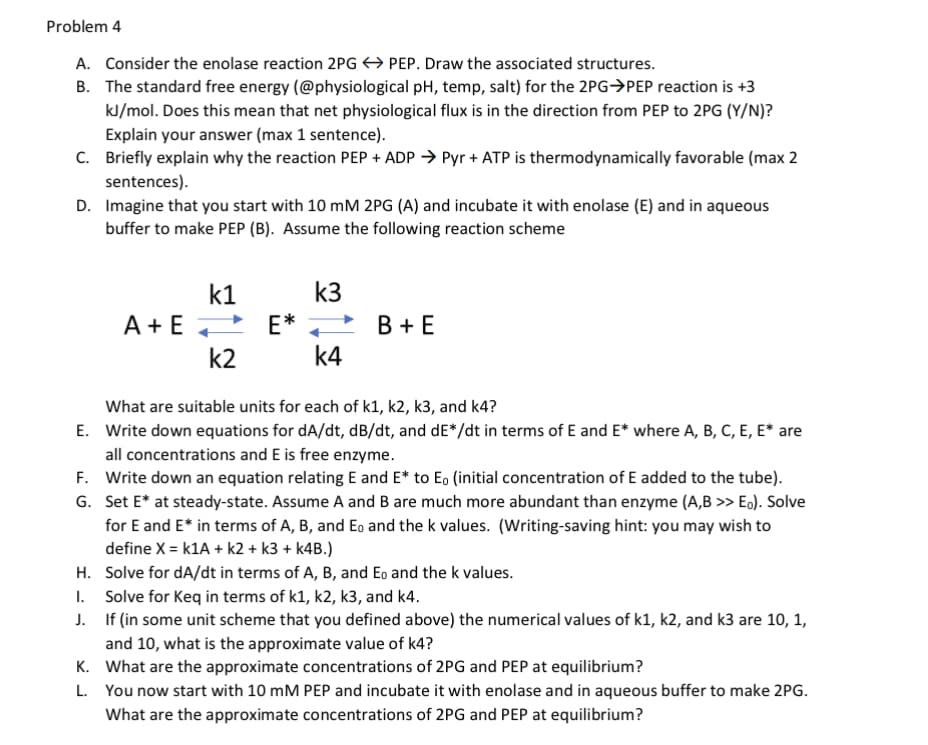Consider the enolase reaction 2PG PEP. Draw the associated structures. The standard free energy (@physiological pH, temp, salt) for the 2PG>PEP reaction is +3 kJ/mol. Does this mean that net physiological flux is in the direction from PEP to 2PG (Y/N)? Explain your answer (max 1 sentence). Briefly explain why the reaction PEP + ADP → Pyr + ATP is thermodynamically favorable (max sentences).
Consider the enolase reaction 2PG PEP. Draw the associated structures. The standard free energy (@physiological pH, temp, salt) for the 2PG>PEP reaction is +3 kJ/mol. Does this mean that net physiological flux is in the direction from PEP to 2PG (Y/N)? Explain your answer (max 1 sentence). Briefly explain why the reaction PEP + ADP → Pyr + ATP is thermodynamically favorable (max sentences).
Chemistry
10th Edition
ISBN:9781305957404
Author:Steven S. Zumdahl, Susan A. Zumdahl, Donald J. DeCoste
Publisher:Steven S. Zumdahl, Susan A. Zumdahl, Donald J. DeCoste
Chapter1: Chemical Foundations
Section: Chapter Questions
Problem 1RQ: Define and explain the differences between the following terms. a. law and theory b. theory and...
Related questions
Question
Pleas solve ASAP

Transcribed Image Text:Problem 4
A. Consider the enolase reaction 2PG → PEP. Draw the associated structures.
B. The standard free energy (@physiological pH, temp, salt) for the 2PG>PEP reaction is +3
kJ/mol. Does this mean that net physiological flux is in the direction from PEP to 2PG (Y/N)?
Explain your answer (max 1 sentence).
C. Briefly explain why the reaction PEP + ADP → Pyr + ATP is thermodynamically favorable (max 2
sentences).
D. Imagine that you start with 10 mM 2PG (A) and incubate it with enolase (E) and in aqueous
buffer to make PEP (B). Assume the following reaction scheme
k3
E*
k4
k1
A + E
В + Е
k2
What are suitable units for each of k1, k2, k3, and k4?
E. Write down equations for dA/dt, dB/dt, and dE*/dt in terms of E and E* where A, B, C, E, E* are
all concentrations and E is free enzyme.
F. Write down an equation relating E and E* to Eo (initial concentration of E added to the tube).
G. Set E* at steady-state. Assume A and B are much more abundant than enzyme (A,B >> E,). Solve
for E and E* in terms of A, B, and Eo and the k values. (Writing-saving hint: you may wish to
define X = k1A + k2 + k3 + k4B.)
H. Solve for dA/dt in terms of A, B, and Eo and the k values.
1. Solve for Keq in terms of k1, k2, k3, and k4.
J. If (in some unit scheme that you defined above) the numerical values of k1, k2, and k3 are 10, 1,
and 10, what is the approximate value of k4?
K. What are the approximate concentrations of 2PG and PEP at equilibrium?
L. You now start with 10 mM PEP and incubate it with enolase and in aqueous buffer to make 2PG.
What are the approximate concentrations of 2PG and PEP at equilibrium?
Expert Solution
This question has been solved!
Explore an expertly crafted, step-by-step solution for a thorough understanding of key concepts.
Step by step
Solved in 4 steps with 4 images

Knowledge Booster
Learn more about
Need a deep-dive on the concept behind this application? Look no further. Learn more about this topic, chemistry and related others by exploring similar questions and additional content below.Recommended textbooks for you

Chemistry
Chemistry
ISBN:
9781305957404
Author:
Steven S. Zumdahl, Susan A. Zumdahl, Donald J. DeCoste
Publisher:
Cengage Learning

Chemistry
Chemistry
ISBN:
9781259911156
Author:
Raymond Chang Dr., Jason Overby Professor
Publisher:
McGraw-Hill Education

Principles of Instrumental Analysis
Chemistry
ISBN:
9781305577213
Author:
Douglas A. Skoog, F. James Holler, Stanley R. Crouch
Publisher:
Cengage Learning

Chemistry
Chemistry
ISBN:
9781305957404
Author:
Steven S. Zumdahl, Susan A. Zumdahl, Donald J. DeCoste
Publisher:
Cengage Learning

Chemistry
Chemistry
ISBN:
9781259911156
Author:
Raymond Chang Dr., Jason Overby Professor
Publisher:
McGraw-Hill Education

Principles of Instrumental Analysis
Chemistry
ISBN:
9781305577213
Author:
Douglas A. Skoog, F. James Holler, Stanley R. Crouch
Publisher:
Cengage Learning

Organic Chemistry
Chemistry
ISBN:
9780078021558
Author:
Janice Gorzynski Smith Dr.
Publisher:
McGraw-Hill Education

Chemistry: Principles and Reactions
Chemistry
ISBN:
9781305079373
Author:
William L. Masterton, Cecile N. Hurley
Publisher:
Cengage Learning

Elementary Principles of Chemical Processes, Bind…
Chemistry
ISBN:
9781118431221
Author:
Richard M. Felder, Ronald W. Rousseau, Lisa G. Bullard
Publisher:
WILEY